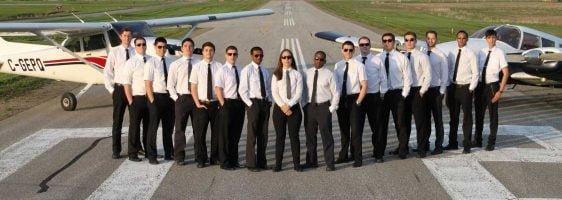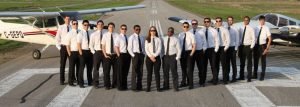Physical Address
304 North Cardinal St.
Dorchester Center, MA 02124
Physical Address
304 North Cardinal St.
Dorchester Center, MA 02124

Some people who are eager to enroll in commercial pilot training are unaware of what or who a commercial pilot is, or the responsibilities that accrue from being a pilot. You may assume that someone who is a commercial pilot is an airline pilot. While it is true that an airline pilot is a commercial pilot, the opposite is not always the case: a commercial pilot is not necessarily an airline pilot.
Commercial pilots can be cargo pilots, backcountry pilots, or tour pilots, and if you want to become a licensed pilot, then, this is your responsibility. They can be flight instructors, ferry pilots, or glider pilots. A commercial pilot is simply one for which the FAA – Federal Aviation Administration allows you to charge money for services. To fly a scheduled regular passenger service or for an airline, you need to receive additional requirements for these specific jobs. For example, an airline pilot must have a commercial pilot certificate with an air transport certificate (ATP) and work for a regular airline or certified operator to collect or charge money.
In this guide, we will be discussing the important details on how to become a commercial pilot; The training involved, and what you should expect to be the cost for your commercial pilot training and getting your license or certificate.

To fly as a commercial airline pilot after you have taken the training, you need 1,500 hours of experience, which might take up to two years. ATP’s accelerated commercial pilot training programs provide a structured schedule and shorten the time required to gain experience and meet requirements. Get the training, certifications, and flight times you need to start your airline pilot career as quickly as possible.
Also Read: How to become a pilot with or without a degree
In general, commercial pilots are responsible for controlling an aircraft. In addition to scheduled flights, charter flights, emergency aircraft, rescue operations, and crop dusters can also be flown by them. The tasks of a licensed commercial pilot include making sure of the balanced weight distribution of the aircraft, communicating with air traffic control, operating and controlling aircraft, monitoring indicators, aircraft navigation, and, if necessary, carrying out emergency measures.
Currently, commercial pilot training costs between £50,000 and £100,000. The cost of commercial pilot training depends on the flight school you are training and the type of training you are receiving.
A full-time commercial flight course (referred to as an integrated course) at a European flight school costs over £80,000 to around £120,000.
Part-time training or a course in various flight training organizations (referred to as modular training) starts between £40,000 and £60,000.
Commercial pilot training costs vary across countries of the world. it is important that you find out about the training cost for commercial pilots in your own locality.
If you’re interested in becoming a commercial pilot, don’t be intimidated by flight pilot training ideas. Commercial pilot training is generally not done with a jet, although it is possible. Many people obtain the commercial pilot license on the same aircraft that they used to complete their private pilot certificate in a small four-seat aircraft. The main difference is that students must earn 10 flight hours in a high-performance aircraft for a commercial certificate or license. Some therefore opt for the entire training in a high-performance aircraft.
Integrated flight training refers to a commercial full-time flight training course where all training is offered by the same special flight training organization. Students who complete integrated flight training can complete the course with fewer flight hours than necessary if they complete it via the modular route. An integrated full-time course usually lasts between 14 to 18 months depending on the climate and the satisfactory progress of the students in each phase.
Modular flight training refers to the gradual implementation of your flight training. You can do the training at your own pace according to how your free time and finances allow it. It is usually cheaper than integrated training and offers you maximum flexibility.
Usually, you follow your modular flight training in the following order:
Now it seems you have made up your mind to become a commercial pilot, and you have gotten acquainted with the cost, now let’s about the steps you must complete before you become a commercial pilot.
Applicants for commercial pilot training must be at least 18 years old, and be able to read, speak, write, and understand English. Having a private pilot certificate is also an important requirement. The most common reason why people cannot start their commercial pilot training is lack of experience. A pilot needs at least 250 hours to obtain a commercial pilot license.
Since you must possess a private pilot certificate to start commercial training, you probably already have an aviation medical certificate. If you have a third-class medical certificate, you may want to get a second-class medical certificate. You need at least a second-class medical certification to use your commercial pilot license, and there is nothing worse than realizing that you cannot pass a second-class medical exam if you have completed your commercial training.
Take the written FAA examination for extra knowledge. By doing so, you will have first-hand experience that will serve as a refresher when you are on leave. Once you have completed your written exam, you can concentrate on the flight training.
A commercial pilot candidate must demonstrate competence and experience. To obtain a commercial pilot certificate according to CFR Part 61, you need at least 250 flight hours, including 100 hours of pilot in charge and 50 hours of cross-country flight. In addition, you must earn at least 10 hours of instrument training and 10 hours on a complex aircraft.
During your commercial pilot training, you learn new maneuvers and have to be more consistent and precise than during private pilot training. You will also learn to do longer flights across the country, including at least one flight across the country that spans a total of at least 300 nautical miles and a single leg of at least 250 miles.
Once you have mastered commercial flight maneuvers according to the new standards and have learned everything about the privileges and limitations of the commercial pilot certificate, your instructor will sign you up for the check ride. Since you have already completed the check rides before, you know what to expect: a few hours of preparatory work is enough for the oral part of the exam and a quick flight.
Remember that the examiner will test to determine what type of professional pilot you will be. Therefore, act very professionally at all times. Don’t skimp on seat belt briefing, and keep in mind that accuracy is critical. Don’t do anything that seems sloppy.
A commercial pilot license (CPL) is a pilot license that allows the holder to act as an aircraft pilot and receive payments for his/her work.
The basic requirements for obtaining the license and the associated privileges are internationally agreed upon by the International Civil Aviation Organization (ICAO). However, the actual implementation varies widely from country to country. According to the ICAO, the applicant must:
The JAA – Joint Aviation Authority has a good number of approved courses that result in the issuance of a commercial JAA pilot license with an instrument rating without first obtaining a private pilot license. At the end of these requirements, the candidate will be given an exam by the aviation authority, including an oral and practical flight exam by an examiner. Applicants for a CPL (airplanes) must have also completed a field flight of at least 300 nautical miles with a full landing at two different of origin.
Various types of commercial pilot certificates or licenses are issued for the main categories of aircraft: airplanes, planes, gyroscopes, helicopters, balloons, and gliders. As indicated below, they can all appear in the same document, depending on the jurisdiction that issued them.
Required qualifications for you to become a commercial pilot include being at least 18 years old, holding a high school diploma or equivalent, having a second-class or first-class FAA medical certificate, and being fluent in English for international communication.
Your career as a pilot starts with you earning a private pilot license with a minimum of 40 flight hours. You also need to accumulate flying hours to meet the requirements for further training, train for commercial flying and meet flight-hour requirements, and learn to fly in different weather conditions using only instruments.
Commercial pilot training programs cover aviation regulations, meteorology, aircraft systems, and navigation. For flight training, you need flight lessons with certified instructors. You will also take written exams, flight tests, and medical evaluations.
Generally, costs for training will vary based on location, training school, and type of aircraft used. However, expect to pay between $8,000 to $15,000 for a private pilot license, $5,000 to $10,000 for instrument rating, and $25,000 to $35,000 for a commercial pilot license. On average, the total training cost is about $50,000 to $100,000.
Accelerated training programs last up to 1 to 2 years, while part-time training takes about 2 to 4 years depending on your schedule.